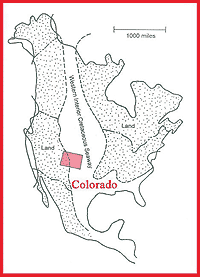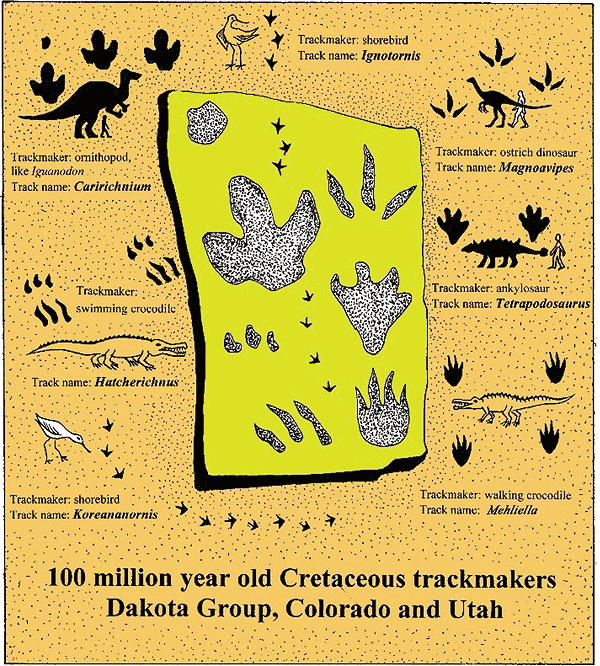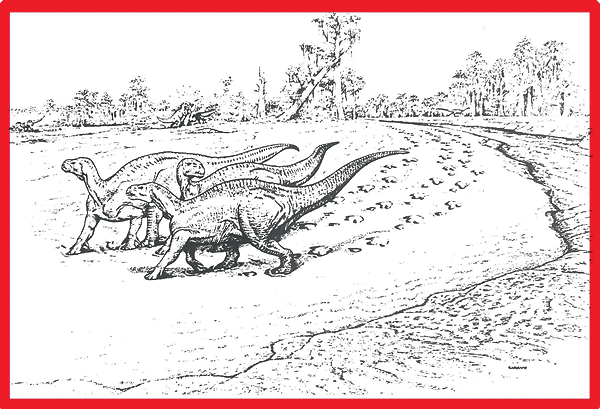 |
| 100 million years ago North America was split by the Cretaceous Western Interior Seaway which created extensive coastal plains suitable for track making in sediments that are now the Dakota Sanddstone |
Moab residents have heard of the imminent plans to break ground on Utahraptor State Park (USP). Over the years the area, encompassing the historic Dalton Wells site, has produced a remarkable number of dinosaurs from what is known as the Cedar Mountain Formation, prompting claims by the paleontological community that this is a Cretaceous Park with a diversity of species greater than found anywhere else in the world. (Incidentally the Dalton Wells area was used as barracks for CCC depression era workers and then as a World War II internment camp for Japanese).
But what has this to do with the art of tracking? First, as last month’s contribution reminds us, the whole area is replete with Jurassic tracks at least 150 million years old. Second, as we move forward in time to the Cretaceous there are also tracks found in the Cedar Mountain Formation (in the age range of 130-110 million years) but they are not often discussed. Herein lies a story about the different ways in which tracks and bones are studied and viewed.
Until quite recently (2004) the few tracks found in the Cedar Mountain Formation were considered of little importance. This was because they were so few in number and poorly preserved. However, the picture has changed due to the discovery and description of three tracksites, all just outside Utahraptor State Park, but nevertheless all very nearby. One site is in Arches National Park, another in the Yellow Cat area, and the third at the Mill Canyon Dinosaur tracksite (MCDT) now easily accessible as an interpretative destination developed by the BLM in conjunction with research partners (joint Univ. Colorado Denver-Korean researchers and Moab Giants). So, what do these sites add to our understanding derived from the discovery of so many bones from the Cedar Mountain Formation?
Not all rock formations are created equal. They are composed of different rock types (sandstone, shale, limestone etc.,). Some are thick, some thin, some represents deserts others swamps. These differences affect the preservation of bones, better in alkaline, non-acidic, soils but rare in acidic swampy habitats. So, part of the art of tracking is to look in the right formations. As we shall see later in this, series tracks are common in deposits in the late Cretaceous swampy, delta deposits. In fact, some of these deposits have only tracks and no bones, even though the footprints prove animals were there. Bone fossils get excavated, but tracksites are mostly developed in place. This means the planned bone and skeleton reconstructions for Utahraptor State Park are necessary for visitors to see what these famous animals looked like.
 |
| Diverse fossil footprints from the Dakota Sandstone include the tracks of at least three dinosaur groups, birds, crocodiles, turtles and pterosaurs. The yellow slab on display at Dinosaur Ridge was sculpted to show the main track types. |
So, back to our three important Cedar Mountain tracksites? The first, described in 2004, was found, off the beaten path, in Arches National Park. It revealed tracks of theropod dinosaurs and sauropods. The site also produced what may be the first, and very deep Utahraptor-sized dromaeosaur track found in the USA. The depth indicates a soft ‘squishy’ substrate. The second site, described in 2014, is the publicly-accessible, interpretative Mill Canyon site. Here again there are tracks of both theropods and sauropods of different sizes, including two trackways of dromeosaurid raptors, which are the only trackways (consecutive steps, not isolated footprints) known in North America. There are also clear tracks of Iguanodon-sized ornithopods, a very faint bird track and possibly crocodiles. In all a dozen types (species) may be represented. The third site in the Yellow Cat area revealed a beautiful set of bird tracks, from a slab collected by the Natural History Museum of Utah. Despite the rich bone evidence of many species from the Cedar Mountain Formation, these provide the first evidence the presence of birds that appear to have been like modern shorebirds. Although the rich bone record is rightly celebrated, tracks prove useful in confirming the high animal diversity and showing the presence of a major group (birds) previously unknown from the area.
 |
A typical scene along the shores of the Cretaceous Western Interior Seaway, AKA the Dinosaur Freeway, shows three iguanodontid dinosaurs leaving trackways along the shoreline. |
|